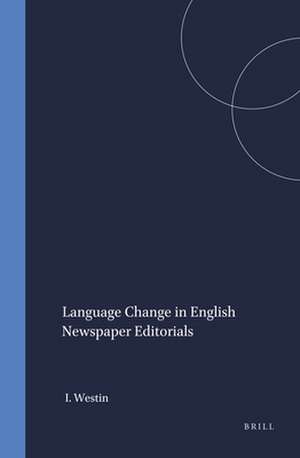Language Change in English Newspaper Editorials: Language and Computers, cartea 44
Autor Ingrid Westinen Limba Engleză Hardback – 31 dec 2001
To begin with, sets of features associated with the empirically defined dimensions of linguistic variation presented in Biber (1988) were compared across decades and newspapers; these dimensions included personal involvement and information density, narrative discourse, argumentative discourse, abstract discourse, and explicit reference. However, since the study showed that the features within each set often developed in diverging directions, the old sets were broken up and new ones formed on the basis of change and continuity as well as of shared linguistic/stylistic functions, specific for newspaper editorials, among the features involved. It then became apparent that, during the 20th century, the language of the editorials developed towards greater information density and lexical specificity and diversity but at the same time towards greater informality, in so far as the use of conversational features increased. The narrative quality of the editorials at the beginning of the century gradually decreased whereas their reporting and argumentative functions remained the same over the years.
When the features were compared across the newspapers analyzed, a clear distinction was noticed between The Times and the Guardian. The language of the Guardian was the most informal and the most narrative while that of The Times was the least so. The information density was the highest inThe Times and the lowest in the Guardian. In these respects, the Daily Telegraph took an intermediate position. The editorials of the Guardian were more argumentative than those of both the Daily Telegraph and The Times. As regards lexical specificity and diversity as well as sentence complexity, the Daily Telegraph scored the highest and The Times the lowest while the results obtained for the Guardian were in between the two.
Din seria Language and Computers
- 18%
 Preț: 552.70 lei
Preț: 552.70 lei - 15%
 Preț: 387.46 lei
Preț: 387.46 lei -
 Preț: 187.83 lei
Preț: 187.83 lei -
 Preț: 148.94 lei
Preț: 148.94 lei - 18%
 Preț: 565.96 lei
Preț: 565.96 lei -
 Preț: 401.34 lei
Preț: 401.34 lei -
 Preț: 233.52 lei
Preț: 233.52 lei -
 Preț: 363.69 lei
Preț: 363.69 lei - 18%
 Preț: 565.18 lei
Preț: 565.18 lei -
 Preț: 192.97 lei
Preț: 192.97 lei - 15%
 Preț: 403.44 lei
Preț: 403.44 lei - 15%
 Preț: 481.60 lei
Preț: 481.60 lei - 15%
 Preț: 372.69 lei
Preț: 372.69 lei - 18%
 Preț: 775.01 lei
Preț: 775.01 lei - 15%
 Preț: 372.20 lei
Preț: 372.20 lei - 15%
 Preț: 371.85 lei
Preț: 371.85 lei -
 Preț: 309.21 lei
Preț: 309.21 lei - 18%
 Preț: 607.03 lei
Preț: 607.03 lei -
 Preț: 382.18 lei
Preț: 382.18 lei - 15%
 Preț: 403.96 lei
Preț: 403.96 lei - 15%
 Preț: 481.25 lei
Preț: 481.25 lei - 15%
 Preț: 443.14 lei
Preț: 443.14 lei - 15%
 Preț: 441.00 lei
Preț: 441.00 lei - 15%
 Preț: 393.35 lei
Preț: 393.35 lei - 15%
 Preț: 455.39 lei
Preț: 455.39 lei - 18%
 Preț: 575.84 lei
Preț: 575.84 lei - 18%
 Preț: 600.17 lei
Preț: 600.17 lei - 18%
 Preț: 560.95 lei
Preț: 560.95 lei - 18%
 Preț: 594.00 lei
Preț: 594.00 lei - 18%
 Preț: 522.84 lei
Preț: 522.84 lei - 18%
 Preț: 636.47 lei
Preț: 636.47 lei - 18%
 Preț: 703.78 lei
Preț: 703.78 lei - 18%
 Preț: 727.08 lei
Preț: 727.08 lei - 15%
 Preț: 503.69 lei
Preț: 503.69 lei
Preț: 376.52 lei
Preț vechi: 442.96 lei
-15% Nou
Puncte Express: 565
Preț estimativ în valută:
72.08€ • 75.21$ • 60.42£
72.08€ • 75.21$ • 60.42£
Carte indisponibilă temporar
Doresc să fiu notificat când acest titlu va fi disponibil:
Se trimite...
Preluare comenzi: 021 569.72.76
Specificații
ISBN-13: 9789042008632
ISBN-10: 9042008636
Dimensiuni: 155 x 230 mm
Greutate: 0 kg
Editura: Brill
Colecția Brill
Seria Language and Computers
ISBN-10: 9042008636
Dimensiuni: 155 x 230 mm
Greutate: 0 kg
Editura: Brill
Colecția Brill
Seria Language and Computers
Recenzii
”commendable” in: Journal of Historical Pragmatics, 7:1 (2006)
Cuprins
Acknowledgements. Tables and Figures. 1. Introduction. 2. Methodological considerations. 3. Features marking personal involvement. 4. Features marking information density. 5. Features marking ‘narrative’ discourse. 6. Features marking argumentative discourse. 7. Features marking abstract discourse. 8. Features marking explicit reference. 9. Towards a description of the modern English up-market editorial. 10. Summary, conclusions, and discussion. References. Appendix.
